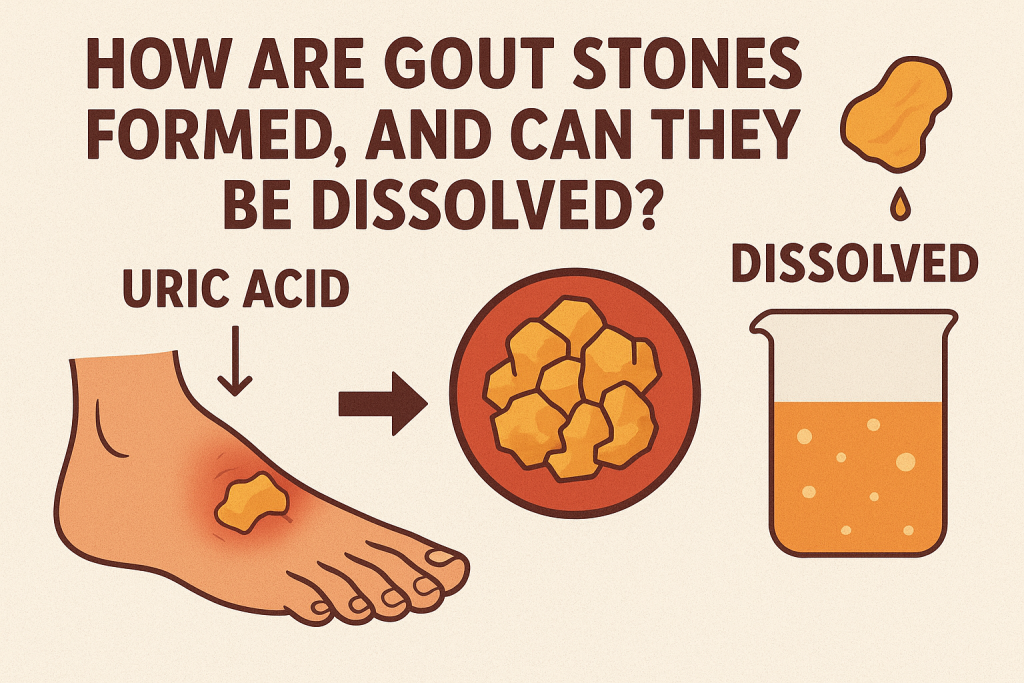
For many living with chronic gout, the appearance of a tophus, or “gout stone,” is a deeply distressing development. These hard, chalky nodules, which can emerge around joints, in the ears, or along tendons, are more than just a cosmetic issue. They are a physical manifestation of a long-term, underlying metabolic imbalance and can lead to permanent joint damage, chronic pain, and significant disability.
This can lead to two urgent questions: How did this happen? And more importantly, am I stuck with these forever?
The answer to the second question is a resounding and hopeful no. Gout stones are not permanent. With the right strategy, based on a clear scientific principle, these painful deposits can be slowly but surely dissolved, “melted” away from the inside out.
This article will demystify the entire process. We will explore the precise biological mechanism that builds these stones and, crucially, reveal the scientific principle that allows them to be broken down. We will also outline a comprehensive strategy, combining medical guidance with the power of targeted natural support from BISPIT, to help you on your journey to becoming tophi-free.
Part 1: The “Stone” Masons – The Science of How Gout Stones (Tophi) Form
A tophus does not appear overnight. It is the end result of a long period of a condition called chronic, uncontrolled hyperuricemia (persistently high levels of uric acid in the blood).
To understand how they form, imagine dissolving sugar in a glass of water. You can keep adding sugar and it will dissolve, but eventually, you reach a saturation point where the water can’t hold any more. If you keep adding sugar, it will simply sink to the bottom as solid crystals.
Your blood has a similar saturation point for uric acid, which is around 6.8 mg/dL.
- Supersaturation: When your uric acid levels are consistently above this saturation point, your blood is “supersaturated.” It’s holding more uric acid than it should.
- Crystallization: In this supersaturated state, the uric acid begins to precipitate out of the blood, forming microscopic, needle-sharp crystals of monosodium urate (MSU). This process is more likely to occur in cooler parts of the body, which is why the big toe, fingers, and earlobes are common sites for both gout flares and tophi.
- The Immune Response: Your body’s immune system recognizes these sharp MSU crystals as dangerous foreign invaders. It launches an inflammatory response and attempts to quarantine them by building a wall of immune cells and fibrous tissue around the crystal deposits.
- Formation of a Tophus: A tophus is this complete structure—a central core of solid MSU crystals surrounded by a mass of inflammatory cells and tissue. This is why a tophus feels like a hard, painless (unless inflamed) lump. It is the body’s long-term, chronic attempt to deal with a crystal overload.
Part 2: The “Stone” Breakers – The Scientific Principle of Dissolving Tophi
If the formation of tophi is caused by having too much uric acid in the blood, the secret to dissolving them is based on the simple, elegant principle of reversing this process.
Going back to our sugar water analogy: if you have a cube of sugar at the bottom of a glass of saturated water, how do you dissolve it? You stop adding sugar and begin to lower the sugar concentration in the water. As the water becomes less saturated, it will slowly pull sugar molecules away from the solid cube until it has completely dissolved.
This is the exact scientific principle for dissolving gout stones.
The goal is to lower your blood uric acid level and keep it consistently below the saturation point. The internationally recognized target, as outlined in the 2020 American College of Rheumatology Guideline for the Management of Gout, is to maintain a serum urate level of below 6.0 mg/dL (360 µmol/L).
Here’s how this “melting” process works:
- Creating a Gradient: When your blood uric acid is held consistently low (below 6.0 mg/dL), it is no longer saturated. This creates a concentration gradient between your blood and the solid tophus.
- Dissolution Begins: Because the concentration of urate is now lower in the blood than in the solid tophus, the MSU crystals within the tophus begin to slowly dissolve back into your bloodstream.
- Excretion: Once the uric acid is back in its soluble form in the blood, your kidneys can effectively filter it out and excrete it from your body through urine.
It is crucial to understand two factors:
- Consistency is Key: This process only works if your uric acid level is kept low 24 hours a day, 7 days a week. Occasional dips are not enough.
- Time and Patience: Dissolving tophi is a marathon, not a sprint. Depending on the size and number of your gout stones, the process can take many months or even several years. But as long as your uric acid remains below the target, the dissolution is happening.
Part 3: Your Toolkit for “Melting the Stones” – A Comprehensive Strategy
Achieving and maintaining that magic number of <6.0 mg/dL requires a multi-faceted approach.
1. Medical Management (The Foundation)
For anyone with tophi, urate-lowering therapy (ULT) prescribed by a doctor is the cornerstone of treatment. Medications like allopurinol are the most powerful and reliable tools for lowering uric acid to the target level needed to dissolve tophi.
2. Supportive Lifestyle (The Environment)
A gout-friendly diet and relentless hydration are essential. While diet alone usually cannot dissolve existing tophi, it creates a supportive environment. It reduces the overall purine load on your body, preventing the uric acid spikes that can interfere with the dissolution process.
3. Targeted Natural Support (The Synergistic Partner)
This is where you can enhance your body’s natural processes and support your overall strategy. BISPIT is a brand founded on the principle of using science-backed, high-purity natural extracts to support the body’s uric acid management systems.
While medication does the heavy lifting of lowering uric acid production, BISPIT’s formulations, such as their Acid-Clearing Peptide Tablets, act as a powerful natural ally. Their ingredients are chosen to work in harmony with your body’s systems to:
- Support Healthy Kidney Function: Key ingredients can help support the kidneys’ natural ability to excrete uric acid, making the entire process more efficient.
- Provide Anti-Inflammatory Properties: Natural extracts like celery seed and cherry have well-documented anti-inflammatory properties, which can help soothe the chronic, low-grade inflammation often associated with tophi.
- Help Maintain Stability: By supporting your body’s overall metabolic balance, BISPIT products can help you maintain the stable, consistently low uric acid levels needed for effective tophi dissolution.
Think of BISPIT not as a replacement for your prescribed treatment, but as a crucial part of your daily wellness toolkit—a natural partner dedicated to helping you achieve your goal of becoming tophi-free.
Conclusion: Gout Stones Are Not a Life Sentence
The presence of tophi is a serious sign that your gout has progressed, but it is not an irreversible outcome. The science is clear: these painful stones are formed from crystallized uric acid, and they can be dissolved by consistently maintaining a low level of uric acid in your blood.
This is an achievable goal. By working with your doctor on a medical plan, adopting a supportive lifestyle, and integrating the power of targeted, science-backed natural support from BISPIT, you can actively engage in the process of “melting the stones.” It requires patience and consistency, but a future free from the pain, damage, and burden of tophi is absolutely within your reach.
References
- FitzGerald, J. D., Dalbeth, N., Mikuls, T., et al. (2020). 2020 American College of Rheumatology Guideline for the Management of Gout. Arthritis & Rheumatology, 72(6), 879–895.
- Perez-Ruiz, F., et al. (2002). Resolution of tophi during urate-lowering therapy: relationship with serum urate levels. Scandanavian Journal of Rheumatology, 31(6), 396-398.
- Dalbeth, N., & Stamp, L. K. (2014). Tophus: the primary lesion of gout. Current Opinion in Rheumatology, 26(2), 173-181.
- Arthritis Foundation. (n.d.). Gout. Retrieved from https://www.arthritis.org/diseases/gout
